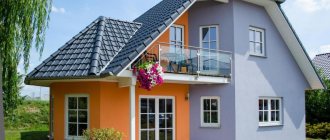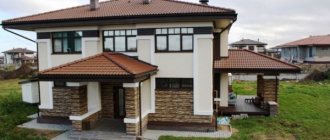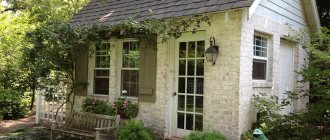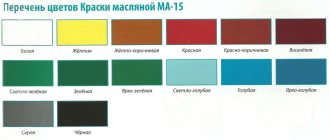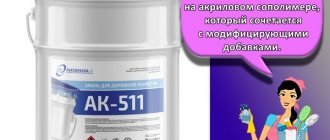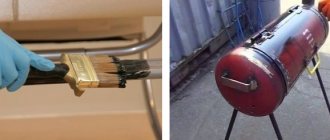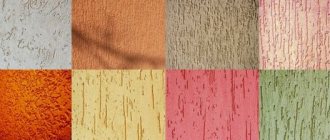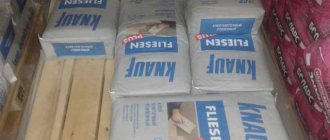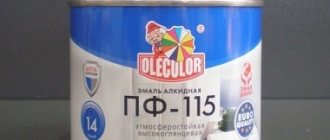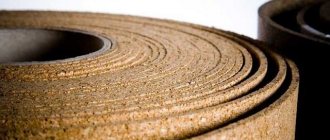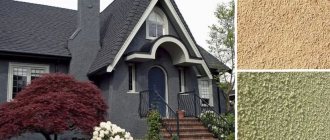What technical characteristics of facade paint are important to the buyer? How do acrylic-based paint solutions compare to competing solutions? How to properly prepare the surface of the facade and apply paint? Let's try to figure it out.
The photo shows the painted facade of the cottage. What are the criteria for choosing façade paint?
How to choose façade frost-resistant paint for exterior work?
When assessing the result of construction or renovation of any building, an important aspect is its appearance.
Impeccable façade finishing adds value to a new home, and returns an old building to its former luster and neat appearance. It is especially important to choose a shade that is in harmony with the overall composition of the site, and the right façade paint, which will preserve the beauty of the building for a long time, without succumbing to the destructive effects of the climate. Almost the entire territory of Russia experiences sub-zero temperatures in winter, and severe frosts in the northern regions. Modern technologies make it possible to produce facade finishing materials with the properties necessary for harsh conditions.
Features and Benefits
Any external coating must meet the following requirements:
- maintain its best qualities despite the loads experienced during operation,
- have high decorative qualities, maintain the declared shade or texture throughout the entire period of use,
- do not prevent steam from escaping from the walls, otherwise frozen drops of moisture will destroy the building when expanding,
- be elastic so as not to crack when the house shrinks,
- protect walls from water penetration,
- be resistant to temperature fluctuations, severe frosts, and ultraviolet radiation.
The building materials market offers a huge range of high quality facade paints. Weather-resistant paint not only meets the specified requirements, but also has a lot of undoubted advantages and special properties, including:
- strength and durability,
- wide range of operating conditions,
- moisture resistance,
- non-flammability,
- resistance to mold, bacteria, fungus,
- quick drying,
- low toxicity,
- ease of application,
- ease of care and cleaning.
Paint consists of filler, pigment and binder. The more binding components there are, the higher its cost.
Frost-resistant paint is sold both ready-made and in the form of a dry powder, which must be diluted with water or a special thinner.
Types and applications
Facade paints vary in their composition and scope of application.
There are few disadvantages to this type of paint. It is applied only in good weather - without rain, cold or heat, which prevent the normal evaporation of moisture during drying and can worsen the technical characteristics of the coating. The water-based composition requires preliminary leveling of the surface, as well as its treatment with a primer.
Silicate coatings include antifreeze additives, lead oxide, and chromium oxide; the formulation may contain azure and liquid glass. These paints create a transparent coating and are used to create designs on the walls of buildings, paint concrete, brick, stone, ceramic walls, as well as for road markings.
Such compositions cannot be applied to surfaces previously painted with adhesive or vitriol solutions - this risks peeling the silicate paint. Disadvantages include high toxicity and high consumption of material, which must be applied in several layers.
It is necessary to work using protective equipment.
How to choose façade frost-resistant paint for exterior work?
What are the advantages of façade frost-resistant paint for exterior use? Application technology, various types of paint, famous manufacturers.
What properties should concrete paint have?
Since concrete walls are quite capricious, the requirements for dyes for such surfaces should be increased:
- adhesive properties. Facade paints must have a high penetrating ability for deep adhesion to the surface. To improve these properties of painting materials, it is recommended to prime the surface before painting;
- moisture resistance. Considering the ability of a concrete coating to absorb moisture, manufacturers add special additives to painting materials that can repel water. The higher this ability, the better the paint;
- wear resistance. An important indicator that characterizes the service life of the dye is its abrasion. The more aggressive influences a coloring material can withstand, the higher its endurance rating;
- resistance to solar radiation. Ultraviolet radiation negatively affects the color pigment of the paint: with a low sun resistance, the paint quickly loses its color saturation, brightness and attractiveness, and can peel off. Exterior paints must have high resistance to sunlight;
- vapor permeability. The chemical composition of paints must be designed in such a way as to have the ability to release accumulated moisture. Considering that concrete easily absorbs moisture, if the coating is completely sealed, it will accumulate between the surface and the coating, which will lead to the destruction of the dye and base during temperature fluctuations;
- resistance to pollution. Most paints have good stain resistance: they are not able to absorb dirt and are easy to clean. The smoother the painted surface, the less susceptible it will be to the accumulation of dust and dirt;
- drying time. Drying the outer paint material as quickly as possible ensures the least chance of exposure to rain; the faster the paint dries, the better;
- consumption per 1m2. Concrete requires a large consumption of dye, so you should start from the characteristics of the chosen paint;
- saturation. The indicator is directly related to consumption: the higher the saturation, the lower the consumption. The concrete base requires complete painting, since the gray reflections of the coating are not aesthetically pleasing and unattractive.
NOTE!
Due to the increase in strength and wear resistance, exterior paints may contain some elements harmful to health.
In this regard, it should be borne in mind that such paints are not suitable for indoor use.
Facade paint “AKRIAL”, “AKRIAL-MO”, “Akrial-C”
General information:
- GOST, TU: TU 2313-005-04002214-00 amended. 1, 2, 3
- Manufacturers: JSC “Podolsk Construction Materials Plant”
- OKP code: 2329163001
Characteristics
Technical specifications:
- The appearance of the film is a uniform matte surface without wrinkles, pockmarks or foreign inclusions.
- Covering capacity – no more than 170 g/m2.
- Drying time at 20°C – 4 hours.
- Conditional viscosity – 90-120 s.
- The mass fraction of non-volatile substances is at least 70%.
- The degree of grinding is no more than 100 microns.
- The bending strength of the film is no more than 3 mm.
- The strength of the film upon impact is at least 40 cm.
- Application temperature – up to -20°С.
Description: It is a suspension of pigments and fillers in a copolymer solution with the addition of a plasticizer and alkyd resin. Consumption: 200-250 g/m2 with a single layer coating.
Scope of application: Intended for external work on brick, concrete, plaster and metal. VSN, TR, SNiP, Application Guidelines: SNiP 3.04.01-87 “Insulating and finishing coatings”, VSN 45-96 “Instructions for the technology of painting interiors and facades”, TR 79-98 “Technical recommendations for preparing the surfaces of external enclosing structures of residential and public buildings for finishing during their reconstruction and repair”
Characteristics
So, what is the difference between different facade paints?
Density
This is a neutral characteristic by which only the viscosity of the paint and the content of binders and pigments can be assessed to a first approximation. As always, there is a catch. More precisely, two:
- Many manufacturers of cheap paints add fillers to them - neutral substances that increase volume and weight. You get more paint; however, neither the strength of the paint layer nor the hiding power of the paint increases.
- Excessive paint thickness only leads to uneven layers. Streaks appear on vertical surfaces.
However, if the density of the paint differs little from the density of water, you can be sure that this is low quality paint. The norm is 1.4 - 1.5 kg/1000 cm3.
Solvent type
This characteristic determines what can be used to dilute the paint or dissolve a stain placed in the wrong place - water, white spirit, acetone, or some other solvent. Most facade paints are water-based and are diluted with water. But you won’t be able to wash off dried paint. It can only be removed mechanically - with a spatula or grinding.
Vapor permeability
One of the basic rules of construction: the vapor permeability of the wall should increase from the inside to the outside. Accordingly, high vapor permeability is an obvious advantage for facade paint.
The reason for the destruction of the wall is the low vapor permeability of the outer layer of plaster. As a result, moisture accumulates in the wall. Vapor permeability can be expressed in numbers. Manufacturers do this in different ways:
- Sometimes the mass of water vapor that can pass through a square meter of wall in 24 hours is indicated. A good value is 130 grams/m2/24 hours.
- Some manufacturers indicate the SD coefficient. The smaller it is, the more vapor-permeable the paint. The best paint samples have an SD of 0.11 - 0.05. For comparison: a very good façade structural paint, Ceresit CT40, has an SD parameter of 0.3. However, it is applied in a thick layer. A thin layer of Ceresit CT42 has twice the vapor permeability.
- The diffuse resistance coefficient µ means essentially the same thing. An excellent value for µ is considered to be 1400-1500.
Abrasion resistance
Obviously, the higher it is, the stronger the paint layer. Durability is indicated in cleaning cycles. Excellent value - 5000 cycles; This is precisely the declared durability that we see in the above-mentioned acrylic facade paint Ceresit CT42.
Gloss level
In essence, this parameter only means whether the paint in front of us is matte or glossy. Matte is preferable because it masks minor surface defects. Gloss, on the contrary, emphasizes them.
Paint consumption
When technical specifications for façade acrylic paint are indicated, confusion always arises with this parameter. It is due to the fact that different manufacturers often understand quite different things by paint consumption:
- Most often, the consumption of the amount of paint is indicated in grams or milliliters for applying one thin layer to the prepared surface.
- Sometimes the parameter is confused with the hiding power of the paint: the amount of paint required for continuous, uniform painting of a surface of one square meter is indicated. Which means applying at least two layers.
Trying to paint a base in a contrasting color in one coat is a hopeless task.
You will only achieve the appearance of untidy sagging. Another common option is to indicate the area that can be painted with one liter of paint.
If we take into account that the consumption of facade paint strongly depends on the surface of the facade and can vary significantly depending on its condition, confusion is inevitable.
Typical primer paint consumption per coat is 150-250 milliliters per square meter.
Additional Information
In addition to the above, the paint characteristics on the packaging often indicate:
- Drying time for one layer in hours.
- The degree of adhesion to different surfaces in megapascals.
- Moisture resistance to a static layer of water covering the paint, in hours.
- The presence or absence of antiseptic additives.
- Minimum and maximum temperatures for painting work.
Some more information and recommendations from the manufacturer.
How to make the right and economical choice
For exterior work in our region, it is difficult to immediately decide which paint is best to use. In accordance with this, the choice can be made depending on the conditions in which the house will be located and what natural conditions will affect the coating.
It is important to decide what will be specifically painted. On a summer cottage, the facade does not require any special frills in terms of beauty, so you can save money here
For country houses, it is better to choose a more expensive model so that the home has an attractive appearance.
All these factors will directly affect the price. Although for a wooden house it is better if the treatment with paints and varnishes is carried out as rarely as possible. If cheap paints are chosen, then the costs will increase for the purchase of auxiliary materials: primer, solvent. The best option would be a product where the base is oil.
When purchasing, you should pay attention to the following characteristics of the product, which are indicated on the packaging or quality certificate:
The level of resistance, which is determined by a special scale on the packaging. Prevents premature deterioration and corrosion, as well as rapid fading.
The composition must have high vapor permeability. It will protect the natural material from moisture accumulation inside the wood.
Terms of normal operation of the coating. Even when the appearance remains suitable for aesthetic perception, this does not mean that the layer of paint and varnish still protects from external influences.
High elasticity. It is a guarantee that the substance will easily be subject to expansion and contraction, and therefore not deform under the influence of external factors and influences.
Drying times determine the quality and duration of repair work
This condition is especially important if the region is too rainy, since when water gets into the paint, the quality of the coating deteriorates.
The covering ability of the paint material will determine the need for applying an auxiliary layer. This factor influences the need to apply additional layers of the substance to level the surface.
Fire resistance is a determination of the safety of using a finishing agent
Safety is of great importance, since this type of finishing increases the fire hazard of the room.
A salesperson or consultant can tell you about all these points. If the information is not indicated on the packaging, then you can ask about the availability of a certificate. In this way, the quality and uniqueness of the brand will also be checked.
For wood, paint is the best option for finishing. In addition to aesthetics, there is also protection from adverse influences. Naturally, paint is not a very strong finishing layer, since it can be deformed under the influence of mechanical actions.
In order not to spoil the substance and surface of the facade, it is recommended to contact specialists. This is especially true if you do not know all the features of a given finish or the surface is being processed for the first time. Secondary coloring can be done independently.
To extend the service life of this finishing material, you need to carefully prepare the surface and preferably treat it with special means: primer, antifungal solutions. A quality start to a renovation is the main guarantee of its successful completion.
Facade acrylic paint “Proacryl” TU 2316-021-98310821-2009
General information:
- GOST, TU: TU 2316-021-98310821-2009
- Manufacturers: KrasKo Company
- OKP code: 230000
Characteristics
Technical specifications:
- The basis of the material is acrylic resin.
- The appearance of the film is a uniform matte surface.
- Mass fraction of non-volatile substances – 70-75%.
- Conditional viscosity – at least 60-100 sec.
- Drying time at t (20±0.5)°C – no more than 1 hour.
- Covering power in terms of dry film – no more than 180 g/sq.m. m.
- Conditional light fastness – 24 hours.
- Resistance to static exposure to water at (20.0±2)°C – at least 24 hours.
- The degree of grinding is no more than 100 microns.
Description: Proacrylic is a white matte acrylic moisture-resistant water-based paint. It is a material based on an aqueous dispersion of imported acrylates, using ground marble. Weather-resistant, wear-resistant, with high water-repellent properties and high hiding power. It is resistant to washing and abrasion, forms a moisture-resistant, gas-permeable, wear-resistant, durable, environmentally friendly and fireproof coating. Thanks to its ability to “breathe,” the coating becomes moisturized when it rains and dries quickly, while the substrate always remains dry and the paint does not peel off. Quickly reaches the specified level of water resistance. No odor or solvents. Consumption: 0.15-0.2 kg/m2 for a single-layer coating.
Scope of application: Used for painting new and previously painted concrete, cement-lime plaster, sand-lime brick, fiber cement and asbestos cement slabs both outside and inside, as well as for painting walls and facades of buildings, finishing work on concrete, brick, plaster and other porous surfaces. It is possible to use the paint for critical finishing work indoors (European-quality renovation), as well as rooms with high humidity (bathrooms, kitchens, industrial buildings and agricultural buildings). Application temperature is not lower than +5°C.
Application method: The surface must be clean, dry and durable. Old substrates, loose, crumbling and highly absorbent surfaces should be treated with acrylic primer Proacryl-Grunt. Fill any uneven areas with façade putty. Before use, mix the paint thoroughly and, if necessary, dilute with water no more than 10% of the volume. Apply with a brush, roller or spray gun in one or two layers.
Material consumption
On average, this figure fluctuates between 300 g and 400 g of product per 1 sq. m. m, if we are talking about a more or less smooth and even surface. The greater the number of irregularities, the higher the consumption will be. A striking example is work on textured plaster or brickwork.
Porous materials (concrete, brick) absorb huge amounts of moisture. To reduce consumption, a primer mixture is actively used, and it is applied in 2-3 layers. It is better to choose a solution of the same brand as acrylic paint. Primer consumption ranges from 100 to 200 g per 1 sq. m. m.
Paint AK-1114 “Acrial-Spectrum” in various colors TU 2313-002-75351875-2005
General information:
- GOST, TU: TU 2313-002-75351875-2005
- Manufacturers: JSC “Tantal-Lakokraska”
- OKP code: 232916
Characteristics
Technical specifications:
- Drying time – no more than 2 hours.
- Application temperature – not lower than -15°С.
Description: It is a suspension of pigments and fillers in a solution of acrylic resin with the introduction of functional additives. One-component, natural drying, all-season (can be applied at temperatures down to -15°C). Has increased light and water resistance. Service life – at least 10 years.
Scope of application: For protective and decorative finishing of facades of buildings and structures on brick, concrete plastered, wooden and other porous surfaces.
Application method: The paint is applied to a prepared surface pre-primed with “Acrial-Spectrum” composition using a brush, roller, pneumatic or airless spraying in 2 layers. Consumption: 400-600 g/m2.
Scope of acrylic
Paint becomes a shield for concrete:
- from the manifestation of mold and fungal colonization;
- from mechanical damage;
- atmospheric adversities.
Debris particles are first removed from the concrete and the old paint layer is cleaned off. Acrylic is applied to concrete in one layer. This is often enough, which reduces cash costs.
Acrylic CM is considered as a finishing wall cladding or painting in the room of small owners when applied indoors. The surface around the radiators is painted with special acrylic, which does not lose its quality at high temperatures. Dyes for interior work create matte, glossy and pearlescent surfaces.
Matte paint hides defects on the wall, gloss is applied to an ideal surface. Mother of pearl visually increases the space.
Calculation depending on the type of material
The most important parameter that must be taken into account when calculating the required paint composition for facade work is the type of paint. The paint and varnish material is selected depending on the characteristics of your facade. In this case, the consumption for each type will be individual.
Water-based paint
The basis for water-based paint is water, which contains an insoluble emulsion in the form of pigment. After applying such a composition to any surface, the water evaporates and only the pigment base remains in the form of a colored layer.
If you decide to purchase a composition of this type, then you should know that for facade work it is applied in two layers. The time interval between painting two layers should be more than one and a half hours.
- resistance to frost;
- low water permeability;
- lack of response to exposure to ultraviolet rays;
- acceptable cost.
Acrylic paint
Acrylic-based paints and varnishes are an ideal option for facade work. Advantages of acrylic painting:
- duration of preservation of the bright color and protective properties of the coating;
- resistance to aggressive atmospheric factors such as high humidity, wind or direct sunlight;
- ease of maintenance, for which ordinary detergents are sufficient;
- fire safety;
- absolute safety for human health;
- versatility that allows you to process any façade surface, from brick or concrete to solid wood.
As a rule, the consumption of acrylic paint is less than water-based paint. Typically it ranges from 150 to 200 grams per 1 m2. A more accurate consumption of façade paint per 1 m2 depends on how bright you want the painted coating to be. You can finally decide only by directly applying the composition to the surface.
If you get the required shade in one or two layers, then per 1 m2 you will need approximately 130-170 grams. If you need to obtain a more saturated color, you will have to count on 200 grams per 1 m2.
Oil-based paints and varnishes
The oil composition consists of drying oil, color pigments and various fillers. At the same time, fillers can be sold both as part of the paint and in the form of separate solutions. If you are dealing with thickly grated oil compositions, you will have to dilute them a little before applying.
Calculating the consumption of oil paint, like acrylic paint, also depends on the desired brightness of the color. For example, if you apply a small amount of red composition to the surface of façade walls, it will look pink. The standard consumption for painting on plaster is usually 150 grams per 1 m2 and can vary depending on the required color.
Alkyd paint
Alkyd paint and varnish material is based on alkyd resins, which are used in production. Its peculiarity is that for facade work the composition must be diluted with turpentine, kerosene or drying oil. When diluted, each of these components will have an individual consumption of material per 1 m2 of surface to be painted. Therefore, in order to more accurately calculate consumption, you should take into account the number of additional mixtures that are used to obtain a brighter shade.
Traditionally, the consumption of façade paint per 1 m2 of wall surface is small and amounts to about 100 grams. That is, for 10 m2 you will need to spend only a liter of paint. A distinctive feature of the alkyd composition is the creation of a stylish and original appearance. In addition, such paint will protect the facade surface from the appearance of fungi and mold.
Thus, now you know the approximate consumption for each type of paint. At the same time, when choosing a composition for facade work, you need to take into account a number of nuances related to its consumption. This way you will save time and will not have to buy the missing paint. In this case, you will not be left with an excess amount of paint and varnish composition.
Well-known manufacturers, estimated prices and consumption
The market does not experience a shortage of manufacturers of facade paints. Store shelves are full of labels and brand names. The leading positions here belong to companies whose products have earned customers a reputation for consistently high quality.
This unspoken rating includes the German brands Alpina and Cerezit, the Finnish Tikkurila and the English Dulux.
The products of the Russian company Lakra Sintez, which produces the popular line of façade paints Parade and the domestic paint and varnish brand Tex, look decent against the backdrop of famous Western competitors.
To correctly compare costs, we recommend using not “bucket” standards, which each manufacturer has their own (9, 10, 15 liters), but the average price of one liter.
The approximate price of high-quality silicone paint (1 liter) starts from 300 rubles. Siloxane most often costs more than 350-500 rubles/l. The cost of silicate (polysilicon) paint is from 240 rubles.
Lime coloring compounds produced by popular brands are not cheap. Their average price is 260 rubles/l. For comparison, let's say that the same volume of good acrylic paint can be purchased for 200 rubles.
Dry cement and cement-lime paint for facades can be purchased for 140 rubles.
In general, it can be noted that prices for paints of the same type can differ significantly depending on the manufacturer and region of sale. In addition, purchase volumes play an important role; as a rule, the more you take, the cheaper.
The average consumption of facade paint composition on a primed non-porous surface, according to manufacturers, is from 0.18 to 0.25 liters per 1 m2.
How to apply water-dispersion paint to the ceiling, facade, walls
We have prepared some practical tips for applying the material to walls and step-by-step instructions. After reading it, you can get to work, and for clarity, you can watch a video on how to paint a surface
- mix the mixture thoroughly;
- if the surface is being painted for the first time, apply a primer and wait two hours;
- To obtain the desired shade, pigment is added to white paint. It is moistened in water before mixing;
- The first layer of water-dispersion paint should be applied from the side of the window, parallel to it;
- Apply one to three coats using a roller, brush or spray. The interval between layers is 4 hours. The number of layers depends on the quality of the surface being treated;
- the consumption of water-dispersion paint is approximately 140-180 g/m2.
Attention! The very first layer can be applied with a brush in the ratio of half a liter of water per five kilograms of water-dispersion paint. The second layer will be smoother if you paint it with a roller
How to paint a facade
How to paint the facade of a house with your own hands?
Here are the instructions that are relevant for Ceresit acrylic facade paints.
- The base must be strong, dry and free of visible defects.
- Old paint is removed mechanically; The facade is thoroughly cleaned of dust, dirt, grease and primed. As the most universal primer, the manufacturer, of course, recommends using its own product - Ceresit CT17.
- Surfaces affected by fungus and mold must be treated with an antiseptic primer and dried before painting.
- Before use, the paint is thoroughly mixed and applied in two layers. Tool - spray gun, brush or roller.
- Each plane, regardless of size, is painted in one layer in one step. Pauses allowing the paint to dry are unacceptable.
The table contains recommendations for preparing facades from different materials.
Composition of acrylic paints
Acrylic coating is a thin plastic layer. The characteristics of plastic may vary depending on the scope of application of the composition, but essentially the structure of this material remains the same.
Main characteristics of acrylic compositions:
- The binding part is based on polymers that can be soluble in water or an organic solvent. Polymers are responsible for film formation as well as retention of color pigments and additives.
- Another important component of paints are color pigments. These substances are made from acrylic resins. Polymers and pigments combined into one structure form a durable surface that can withstand stress and environmental influences.
- Additives and fillers. These elements are added to the composition to give it certain performance qualities. For example, using fillers you can achieve a glossy or matte surface tone. Additives also make it possible to achieve water-repellent qualities, antiseptic, fire-fighting and other necessary properties.
Polyacrylic paints are produced on the basis of polymers and copolymers of alkyl acrylates. To obtain the desired glass transition temperature, acrylates and methacrylates, as well as styrene, are added to the copolymers. If necessary, special fillers can be added, for example, marble chips.
The resins that make up acrylic paints include special groups of elements that make coatings stronger. Powder paint and varnish compositions are made using epoxy, hydroxyl, and carboxyl groups.
Preparing the ceiling for painting
The quality of acrylic paint on the ceiling is directly dependent on the preparatory stage and the quality of the surface to be coated. Therefore, first of all, it is necessary to carry out work to prepare the ceiling and remove the old finish from it. As a rule, the latter is represented by whitewash, and you can also read about how to remove it on our website. In addition, the surface must be cleaned of dust and dirt, degreased and removed from all flaking parts.
All cracks and chips on the surface should be covered with a primer and finished with putty. If necessary, you can additionally strengthen the surface with a plaster mesh. If the ceiling has already been painted, removing the paint will be very problematic. Therefore, simply remove all poorly adhering fragments and after that you can paint over the layer. But here you should remember that by removing the old paint only partially, you risk getting unevenness on the ceiling that will be very noticeable.
How to receive the ordered product or delivery methods
Our company has representative offices in Krasnodar, Rostov-on-Don, St. Petersburg, Sevastopol and Simferopol. This means that you can buy or receive your purchase from a pickup point. For other regions of Russia, we offer delivery with various types of carrying capacity and vehicle body volume, urgent delivery or door-to-door delivery, cargo insurance and much more. We provide all details on costs and other transportation issues when registering the shipment together with the carrier, since the number of products ordered may vary significantly.
Reliable manufacturers
Most buyers prefer products manufactured by the following companies:
- Tikkurila. The Finnish company offers coloring products intended for treating surfaces indoors and outdoors. The materials are distinguished by high performance qualities and reasonable prices.
- Alpina. German paint and varnish products are premium class. Facing products have good decorative and working qualities.
- “Tex.” The Russian company produces paint and varnish compositions of medium and economy class.
- "Akrial". Produces paints, plasters and other materials for facade finishing.
Less popular brands also produce good products.
How to shorten the drying period
If the dyeing conditions recommended by the manufacturer are followed and the conditions are not changed during drying, then the best result will be obtained. The layer will last longer and be durable. But there are times when it is necessary to shorten the drying period of the paint in order to complete the work faster. Then you can resort to the following:
- Do not use water for dilution, but choose quick-drying products;
- The temperature in the room increases to +25;
- Good ventilation is created.
You can combine heating and ventilation using a hairdryer. If the area is small, then a household one is suitable; for large spaces, a construction one is used.
You can combine heating and ventilation using a hairdryer.
Facade finishing technology with Acrial paint
Application of paint is possible at air temperatures from -20° to + 30°, and there should be no rain, snowfall or strong wind. The application surface must be dry, without frost or drizzle.
- Before starting work, you should prepare the surface. It must be cleaned of old paint, peeling or shedding. All uneven areas or other problem areas must be puttied; in special cases, a leveling layer of plaster is applied. After exposure for the required time, the surface should be coated with a primer (optimally Akrial-Grunt).
- Before application, the material must be thoroughly mixed in the original container; if necessary, diluted with a solvent to a working viscosity.
CAREFULLY!
During operation, the paint should be stirred periodically; the container should not be kept open.
- The material is applied in 1 or 2 layers. For work, use a roller, brushes or spray gun. The paint is applied in an even layer and left for at least 10 hours, after which a second coat can be applied.
- Before using at sub-zero temperatures, it is recommended to keep the material at 18° for 24 hours.
The use of Akrial facade paints allows you to expand the time frame for exterior painting work, since application of the material is possible at low temperatures.
Weather resistance, frost resistance and the ability to firmly bond with most building materials make Akrial paint one of the most preferred external coatings in difficult climatic conditions.
The long service life and strength of the coating film of the material, the ability to obtain any shade of color gives grounds to classify Akrial façade paints as universal types of external coatings suitable for widespread use.
2017-07-14
Calculating paint per 1 m² can be done with some basic knowledge and motivation. Then you can independently calculate how much material will be needed to paint the facade on plaster, this will help save a decent amount of money.
Painting a plastered facade
It is very important that the coating protects the façade of the building from precipitation, extremely low temperatures, wind and scorching sun, as well as from the harmful effects of air and rainwater. Not only the appearance of a newly built or renovated house depends on the type of paint, its quality and tone
The characteristics of the coating determine the longevity and how the house will look in 10 or even 20 years. Therefore, there is no frugality in buying cheap paint and varnish material; paint consumption is not calculated at all in order to save money. It is better to afford to purchase the best quality paint, in which case the facade will look new for a very long time.
Facades plastered and painted
General information about facade paints
Based on the type of approach to exterior work, facade paints are divided into two groups.
- The first group is organic paints, which are never applied to fresh plaster. This group includes silicone compounds, acrylic paints and silicone-acrylic coatings.
- The second group is inorganic (mineral) paints, which can be used to cover fresh, still wet plaster in about a week. Inorganic formulations are less popular than organic ones. These are silicate paints, lime and cement coatings.
Types of facade paints
When choosing the type of paint for a facade, two main factors must be taken into account: the color range and the degree of air pollution. This will allow you to find exactly the product that is ideal for a particular building and will give it an attractive appearance.
| cement | low | narrow |
| limestone | low | narrow |
| acrylic | high | wide |
| silicone | high | wide |
| polysilicate and silicate | high | narrow |
The choice of paint is often determined by the type of plaster. When restoring buildings, the most commonly used paints are lime, cement or cement-lime paints. In modern construction, as a rule, thin-layer plasters, silicone, acrylic-based compounds and silicate minerals are used, which are components of a well-thought-out insulation system for a house built using modern technologies. The easiest way to apply a simple principle when buying paint is that it should be the same type as the plaster.
| Mineral / cement, brick, concrete | Silicate, silicate-silicone, acrylic, silicone, lime, cement |
| Silicate | Silicate, silicate-silicone |
| Acrylic | Acrylic, silicone |
| Silicone | Silicone |
Different bases for different paints
Painting concrete facades
To successfully paint a concrete facade, it must be properly prepared, the most suitable one must be selected, and the time required for drying must be maintained.
- Clean the concrete from old paint, dirt, and plaque. If there is mold, moss, or fungi on the surface, they must be removed.
- Seal all cracks, holes, and uneven areas, as moisture can accumulate there under the paint layer, which as a result will begin to peel off and move away from the concrete. The surface should be as smooth and even as possible.
- Begin work when weather conditions are favorable. It's best to have 2-3 days in a row without rain before you start painting.
- To ensure a high-quality coating, it is recommended to apply a layer of primer. This is especially true if the paint is applied over an old layer that is different in color from the new one.
- In the process of painting the facade, scaffolding or ladders, rollers, gloves, and buckets will be useful. It is better to prepare these materials in advance so that everything is at hand during work.
- Calculate the area that needs to be painted. Then multiply the resulting number by the average consumption of facade paint (it is indicated on the labels). And multiply the resulting figure by two. Typically several coats are required.
After preparing the concrete, you can begin painting. You should start from a corner or from the top if you are painting a wall. The color is distributed slowly and evenly over the entire surface. Each subsequent layer is applied after the previous one has dried.
It is not recommended to paint freshly plastered facades, as the plaster must “ripen”, usually this happens no earlier than after 28 days. Exterior paints are the best way to improve the appearance of your home and give it a finished, beautiful look.
What surfaces is it suitable for?
Facade water-based paint is suitable for all surfaces except metal. The impact of water on metal causes corrosion, which manifests itself over time on the painted surface in the form of dirty rusty spots.
On plastered surfaces, the use of water-based paints to apply the topcoat is allowed no earlier than 10-14 days or even more (up to a month). The fact is that the water-based coating has low vapor permeability and, if the plaster is not completely dry, will not release the remaining moisture.
In general, facade water-based paints are suitable for finishing:
Due to such wide application possibilities, water-based facade coatings are considered universal finishing materials.
Paint is applied using a roller, brush, and on large surfaces (relevant for facades) using a sprayer.
What factors affect drying time?
How long acrylic paint takes to dry will depend on the rate of evaporation of the liquid, which can be influenced by different conditions. The following factors stand out:
- Temperature indicators;
- Humidity level;
- Air speed;
- Atmospheric pressure;
- Features of the material being painted;
- What thickness is the layer applied?
How long acrylic paint takes to dry will depend on the rate of evaporation of the liquid, which can be influenced by different conditions.
Temperature
The best option for drying a layer of paint would be a range from +18 to 24 degrees. The process slows down significantly at +10 degrees; if the temperature drops to zero, then drying does not occur, but a stage of transition to an icy state begins, and the film coating is destroyed.
When the temperature is high, above the extreme threshold, the lower layers of the material do not complete drying, but the upper ones are already completely dry. As a result, the undried layer breaks the coating due to moisture, and cracks form on the surface.
The best option for drying a layer of paint would be a range from +18 to 24 degrees.
Air humidity
When the humidity in the room is low, the drying time increases. Conversely, if the humidity is high, for example in the bathroom, the process will take longer.
When the humidity in the room is low, the drying time increases.
Airflow speed
When paint is applied to the surface, the air in this part becomes more humid, due to the fact that the process of evaporation of moisture from the composition starts. Accordingly, this factor slows down drying. To increase the drying rate, you can accelerate the air by increasing the air flow rate.
To increase the drying rate, you can accelerate the air by increasing the air flow rate.
Atmosphere pressure
There is only one principle of influence here: the higher the pressure, the faster the drying speed. From the pressure, liquid particles seem to be pushed out of the surface.
There is only one principle of influence here: the higher the pressure, the faster the drying speed.
Base surface
The drying speed depends on the type of material that will be painted. After all, some materials absorb liquids well, while others do not have this property. For example, wooden floors. So on plaster, fabric, plasterboard sheets, paper sheets, drying will be completed more quickly than on a metal, plastic or glass surface.
The drying speed depends on the type of material that will be painted.
Paint layer thickness
You can dry the paint faster if you make the application layer thinner. More liquid paint will be applied thinner; for this you can add water or thinner, but it is important not to overdo it so as not to lose the properties of the paint.
You can dry the paint faster if you make the application layer thinner.
Advantages and disadvantages of VGT
Any material has its positive and negative characteristics. VGT is characterized more on the positive side, but has minor disadvantages.
Advantages
A certain advantage of this paint is its color fastness: the white color does not turn yellow over time, and the colored color remains bright throughout the entire period of use.
Other advantages of facade VGT include:
- environmental friendliness (the material does not emit harmful substances);
- wear resistance (withstands mechanical stress, often used for anti-vandal purposes);
- good adhesive ability in relation to any type of surface (good adhesion is formed with surfaces made of concrete, brick, plasterboard, wood and others);
- non-toxic (does not contain hazardous substances, has a slight odor when applied);
- prevents the formation of mold (contains elements that prevent the growth of bacteria);
- ease of application (elasticity);
- vapor permeability (the painted surface “breathes”);
- hypoallergenic.
Compared to branded manufacturers, VGT has a relatively low price, but is not inferior in quality. Various types of façade coloring compositions have been developed taking into account the climatic conditions of Russia.
Flaws
A disadvantage that is revealed in practice when using façade VGT is its weak covering ability. However, this fact is controversial: when coated in several layers, the paint is more durable, despite the fact that consumption increases.
Purchase and storage of coverage
On the Internet, on various industrial and construction portals, you can find a lot of proposals for the implementation of acrylic VDK.
Serious companies always guarantee the quality of any paint coating, provide it with reliable storage conditions, and they usually do not have any difficulties with delivery of the goods.
The presence of water in paint components creates some restrictions on storage and transportation methods.
Containers for these purposes must be made of corrosion-resistant materials - stainless or polymer.
VDK cannot be stored at sub-zero temperatures. The permissible freezing limit is no more than 5 times. Transportation is allowed for one month at a temperature of −20 °C, if this can be controlled. This is the only minor drawback for the consumer.
New technologies for the production of acrylic water dispersions make it possible to use their unique properties to coat almost any materials and structures, increasing their resistance to fire and corrosion.
They are not inferior in quality to pentaphthalic paints for painting wooden surfaces, but they dry very quickly and do not have toxic fumes with an unpleasant odor.
This encourages buyers to choose VD-AK and forget about the usual enamels and varnishes collecting dust on the shelves.
